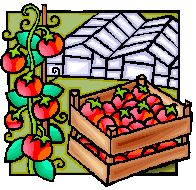

To send a message to an author, click on the author's name at the end of the article.
This Month in Ag Connection | Ag Connection - Other Issues Online
One of the most revered summer vegetables by home gardeners is the tomato. The past three growing seasons has been very wet in Central Missouri, which aggravated our most common foliar diseases, often referred to as blights. These diseases are caused by two fungi, Septoria leaf spot and Early Blight, and two bacteria, Bacterial Spot and Speck. The disease descriptions are presented below, and one web site link provides color pictures, to aid one in trying to diagnose a foliar problem they may have experienced. However, correct diagnosis can be extremely challenging, especially when two or more diseases are occurring at the same time, as has often been the case in the last three years. Please note that bacterial diseases are controlled with different chemicals than fungal diseases, as the biology of the diseases are different. Many gardeners have been applying a fungicide when they have had a bacterial disease or a copper product when they've had a fungal disease. However, the biggest problem has been inattention to disease prevention, which begins at planting, and is the focus of the remainder of this article.

Preventing foliar diseases should start by minimizing disease inoculums, which can be harbored on diseased plant residue or wooden stakes in contact with it. Dispose of tomato residue away from the vegetable garden, or burn it. If tomato diseases have been a problem, consider changing to metal stakes/support or sterilize wood stakes. Mulching around plants will help by reducing soil that splashes up during heavy rainfall onto the lower leaves. However, organic mulches like straw will suppress soil temperatures and may keep the soil too wet during periods of heavy rainfall in the spring. This can aggravate a common root/stem rot- Fusarium wilt (see below). Commercial growers use plastic mulch (usually black) to warm the soil and prevent splashing of soil particles, but home gardeners are reluctant to use plastic because it requires irrigation under the plastic. Black weed barrier cloth, 'landscaping fabric' or a similar product is an ideal choice of material as it allows water to pass through, while still providing the benefits of plastic mulch.
Many gardeners wait until they see disease symptoms before they apply a chemical for disease control. This is later than desired, as 'preventing' the disease is easier than controlling it. Applying a chemical control is best at the onset of weather conditions favorable to foliar tomato blights. These conditions are spells of several days of rainy, warm and humid weather, which typically begin in late May to early June. Thus a good 'plan' is chemical control applied about the 3rd week of May and again two weeks later (1st part of June), while being willing to adjust based on the weather conditions. After a couple of preventative chemical control applications, one can wait to see disease symptoms before continuing with chemical control.
Chemical control by home gardeners of the bacterial diseases is primarily with copper products, which are available in formulations that are approved as organic products. In the last couple of years an organic fungicide has become available to home gardeners which is labeled 'for control or suppression' of all the foliar tomato blights, bacterial and fungal. Serenade Garden by AgraQuest has an active ingredient of QST 713 strain of Bacillus subtilis.
An important cultural control method often overlooked is vigorous growth - dark green foliage typical of a plant with adequate nutrition grown in full sun. Tomatoes in a somewhat shady location (e.g. 3 to 4 hours or more per day) will be more disease prone. Nitrogen (N) is the element most often limiting to plant growth, and tomatoes have the highest N requirement of all vegetables after planting. Sided ressrecommendations are for 1 pound of actual N per 100 linear foot of row at 3 times - one to two weeks before the first fruit ripens, two weeks after picking the first ripe fruit and one month later. Nitrogen can be supplied from natural or synthetic sources, with the latter easier to estimate and apply, as well as being more quickly available to the plant. For detailed information about fertilizing vegetables see the MU Guide 'Steps in Fertilizing Garden Soil: Annual Flowers and Vegetables -http://extension.missouri.edu/explorepdf/agguides/hort/g06950.pdf .
Anthracnose fruit rot was prevalent throughout the Midwest last year, aggravated by the very warm and humid summer conditions. It is spread in an odd way, establishing in the leaf lesions of Early Blight and then splashed onto the fruit. The same chemical controls for Early Blight also control it.
*Sanitation includes removing plant debris from the garden, whether it originates in the current growing season or the previous year. Remove affected plants from the garden and destroy them so that they do not act as a source of disease-causing microorganisms. Discard any plant, transplant, or seed piece that does not look healthy. Diseased plants should not be added to home compost piles; the temperature reached in most home compost piles is not high enough to kill plant pathogens.
There are a number of additional diseases and physiological disorders. For more information, including color pictures, see 'Tomato diseases and disorders' from the Department of Plant Pathology by Iowa State University. http://www.extension.iastate.edu/Publications/PM1266.pdf
Common Diseases of the Home Garden by MU Extension provides descriptions and recommended control practices for the popular vegetable crops in Missouri and their most common diseases. http://extension.missouri.edu/publications/DisplayPub.aspx?P=G6203
Submitted: James Quinn, MU Extension Horticulture Specialist
This Month in Ag Connection | Ag Connection - Other Issues Online
In 2009, 3,373 cattle went missing from rural Missouri farms totaling $2.25 million in losses and that number has increased in the past year. A program on rural crime awareness was recently held in Sedalia. The program focused on both livestock and equipment theft. A mix of law enforcement personnel and ag producers participated in the event.
The livestock portion of the program was conducted by Cpl. Dave Mease with the Missouri Highway Patrol. Cpl. Mease is also a lifelong cattle producer and he shared some thoughts on livestock theft and investigating livestock theft.

According to Cpl. Mease, livestock usually sell within about 3 days of the theft relatively close to where they are taken from. Animals require feed and water, which is an expense, so thieves don't want to hang on to them too long. Theft is a crime of opportunity, so pay attention to where your livestock are located relative to public access. Feeding cows in pens next to the road should be avoided since some cattle can easily be lured into the pens, caught and loaded into trailers. Baby calves can be snatched underneath fences if they are next to roads. Lock gates, keep fences in good repair and have good relationships with neighbors. Cpl. Mease suggested photographing cattle, keeping good identification records (ear tag numbers, Bang's tag numbers, brands, etc.) watching for strange vehicles and preventing easy access to cattle, panels, pens, etc. Vary your chore routines if possible, since potential thieves won't know exactly when you will show up. Fraud, bad checks and fake addresses should also be a concern especially if cattle are sold directly off the farm.
If you suspect theft, the first step is to make sure there is an actual theft. Inspect fences for routes of escape, check with neighbors and check other pastures to make sure the cattle are actually gone and haven't just wandered off. It is extremely important to have as much information as possible on the livestock. Keep current, accurate counts of the number of head in a particular location. Provide detailed descriptions of the animals, including identification methods, ear tag numbers, etc. If there is an actual theft, law enforcement will be looking for evidence such as foot prints, tire tracks, empty feed sacks or hay in pens, paint scrapes from trailers on fence posts, direction of travel, etc. so approach the area carefully.
If you suspect livestock or equipment theft, notify local law enforcement, call the Missouri Highway Patrol Rural Crimes Hotline at 888-484-TIPS (8477) or e-mail at ruralcrimes@mshp.dps.mo.gov. Rural crime investigators for Central Missouri are Sgt. J.P. Clark and Cpl. Dave Mease and they can be contacted at (573) 751-3452.
Source: Gene Schmitz, MU Extension Livestock Specialist
This Month in Ag Connection | Ag Connection - Other Issues Online
Research data indicates that weeds are best controlled by the time they are 4 inches tall. Under most growing conditions, the time it takes a weed to grow from four to six inches ranges from two to four days, which can result in a significant yield loss.
Research from Michigan indicated that while controlling 4 inch weeds in 15-inch row soybeans resulted in a 5 bushel per acre yield loss; waiting until the weeds are 6 inches tall resulted in a 10 bushel per acre yield loss. In 7.5 inch row soybeans, controlling weeds at 4 inches tall resulted in a 3 bushel per acre yield loss while controlling at 6 inches tall, resulted in a 14 bushel per acre yield loss. These yield losses will vary with location and the different species of weeds present.
In corn, they found that controlling weeds at 4 inches resulted in no yield loss, but waiting to control weeds when they were 6 inches tall resulted in an 18 bushel per acre yield loss. These results are based on four years of research but are only indications of what can happen. They do indicate the importance of early weed control.
Weeds to watch for:
Morning Glories
Wild Poinsettia
Asiatic Dayflower
Hophornbeam Copperleaf
Fall Panicum
Waterhemp
For current weed research for specific species in Missouri go to http://weedscience.missouri.edu
2011 Pest Management Guide (M171) – is available through your local MU Extension office or online.
Source: Wayne Crook, MU Extension Agronomy Specialist
This Month in Ag Connection | Ag Connection - Other Issues Online

The University of Missouri has recently been notified that the U.S. Department of Agriculture's Centers for Epidemiology and Animal Health and National Agricultural Statistics Service are conducting a survey to collect information on small-scale livestock operations. The survey targets livestock farms with annual sales of agricultural products between $10,000 and $499,999.
All 50 states are involved in the survey. They define a livestock operation as those with cattle, horses, swine, sheep, goats, poultry, aquaculture species, and/or other livestock species. The "short questionnaire", which covers marketing, management and biosecurity, is or has already been mailed to these livestock farms. In addition, non-respondents will be given an opportunity to participate via telephone.
According to USDA, the survey is designed to gather data that will be a resource to provide a more complete picture of small-scale operations and disease risk. If you receive such a survey, please take the time to fill it out as the information will be important in painting a national picture on these livestock issues.
Source: Gene Schmitz, MU Extension Livestock Specialist
This Month in Ag Connection | Ag Connection - Other Issues Online
Publishing Information
Ag Connection is published monthly for Northeast and Central areas of Missouri producers and is supported by the University of Missouri Extension, the Missouri Agricultural Experiment Station, and the MU College of Agriculture, Food and Natural Resources. Managing Editor: Mary Sobba.